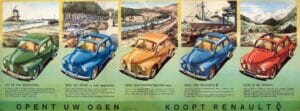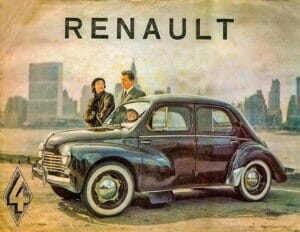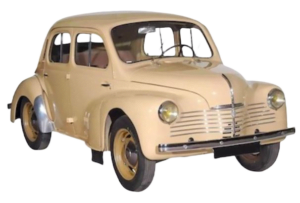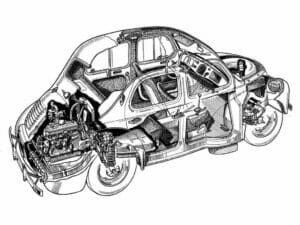Inicio » Our vehicles » Renault 4CV
Share in:
Renault 4CV (Renault 4/4)
Origin: France 1958
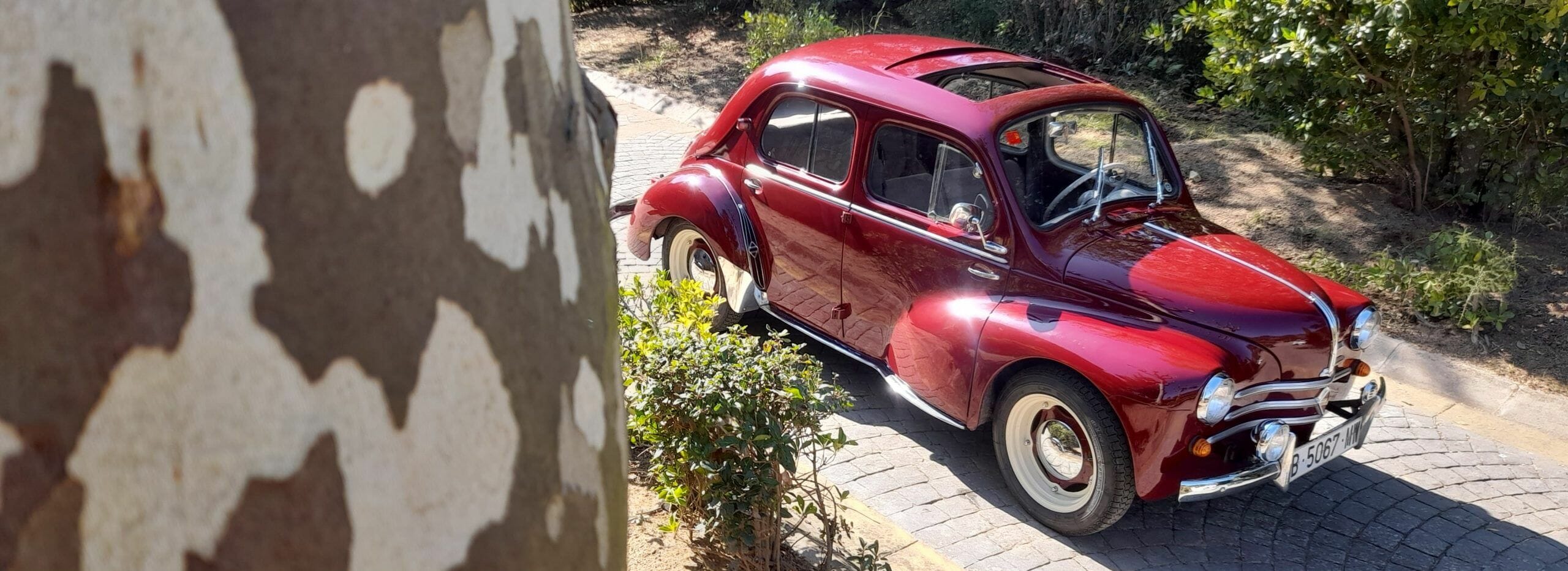
Renault 4CV (Renault 4/4). Our Renault 4CV (or 4/4) is a unit registered in France in 1958 (we don’t know the city although we are trying to find out). It is the SPORT model, and its Ventoux engine delivers 21 HP of power.
.
It was imported in Spain in 1992 by an automotive professional person, who took care of its first restoration: The vehicle was repainted: it was originally green, and was painted in Bordeaux red, the color it currently shows. It was then reupholstered (floors, interior doors, ceiling and seats).
Although it was first registered in 1958, it is possible that the date of manufacture is earlier. This is our assumption because this car has the “star” type wheel rims, and these were discontinued on Renault 4CVs in 1956.
After its first restoration in 1992, the vehicle was active until 2003, when it was stopped and stored in a garage, where it remained until August 2022. In any case, the good conditions in which it was stored made that the vehicle did not suffer from the passage of time or deterioration due to storage.
Additionally, from the mechanical condition we found, we believe that the vehicle was maintained during its last years of operational life -we do not know if before or after its importation into Spain-. For example, we found that the brake cylinders had been renewed, the calipers showed very slight wear, and the rear suspension had been replaced. However, other elements were notoriously affected by the passage of time: the water pump, which had to be replaced due to its obvious poor condition – the internal mechanism was inoperative – or the heating air ducts, which had to be replaced because they were literally destroyed by the passage of time. We also replaced all the hoses in the fuel supply circuit. The radiator was rebuilt, and the entire electrical system was thoroughly overhauled.
We acquired it in August 2022, brought it to our facilies with a tow truck, and we were working on its second restoration until mid-January 2023, when we were able to pass its MOT and put it back on the road.
This vehicle is currently with roadworthiness up to date, and available for rent if you need it for a photo sessions, filming or exhibition. In any case, please feel free to contact us if you have any vehicle-related needs so we can help you.
Also, if you are an owner or future buyer of one of these models and you need any information about parts, spare parts, or technical information you may need, please contact us because we will be happy to share it with you.
Renault 4CV. Photo album. Click on the category:
Renault 4CV - History
1940: Renault 4CV : An almost heroic car, conceived and designed in clandestinity
The Renault 4CV is a car born in clandestinity. During World War II and during the German occupation of France, a group of Renault engineers started to work on a new project.
They knew that the war would not last indefinitely, so it would have to end one day or another, and they knew that the country would need a car that could motorize the country and meet the mobility needs of the population.
Such a car would have to be simple, but reliable. It should be reasonably inexpensive to manufacture. It should be easy to maintain.
It should be inexpensive so that it could reach as many people as possible, but it should be large enough to accommodate four people inside. And so the Renault 4CV was born
One of the problems encountered by Renault engineers was precisely the German occupation of France during that period of World War II. With the Renault factory controlled by the German forces, the rules imposed by the occupiers prohibited any project that was not in the service of the German military to manufacture and maintain military vehicles.
Even so, a team under Fernand Picard orders – one of Louis Renault’s close collaborators – worked on the creation of this vehicle and its three prototypes. Interestingly, Louis Renault himself was not aware (at least not officially, and certainly not at the beginning) of the development of the project, the “106E project” as it was named. It started in 1940 and it took two years, until 1942, for the first prototype to come out. It was reminiscent of the VW Beetle, and although there are voices who claim that the VW Beetle was a source of inspiration, this does not seem very accurate. Other ones claim that the similarity between the two models was due more to the fact that both followed the aerodynamic design guidelines of the time, rather than the fact that one directly inspired the other.
Renault 4CV prototypes during the design phase:
The first tests of the prototype – which miraculously escaped a bombing that the Renault plant suffered – verified a speed of 87 km/hour on the flat surface, as well as the overcoming of a 17% slope in 3rd gear with 4 people on board.
The project was almost discovered by the prince von Urach, manager of the Renault factory appointed by the German invaders, when he questioned Picard about “a green car” he saw passing by the Pont de Sevres. Picard managed to handle the situation as best he could, but temporarily stopped testing and had the prototype repainted black before visibly resuming activities.
The car project was presented to Louis Renault during 1943. A car that Louis Renault did not like, no only because aesthetic reasons, but also because he did not share the concept of a popular car. Nevertheless, the theme continued the project and a second prototype appeared in 1944, this one designed by Roger Barhaud, responsible of the bodywork team department at the Billancourt plant. This second prototype incorporated quite a few changes and was still able to do some tests on the test track.
At the end of 1944, Louis Renault was arrested accused of collaborationism, and Pierre Lefaucheux was appointed manager of the company. And a third prototype would come under his management of the project, which would transform the original two doors into the definitive four-door version. Pierre Lefaucheux was not a great automotive enthusiast, but he saw in the Renault 4CV an opportunity to make the company profitable by offering a mass-produced product that met the needs of the market at the time. It is under this more pragmatic look, with which the third prototype was born in 1945, with 4 doors, which provided an utility more intended for families.
It was in that third version that the engineers noticed that the car had headlights at a height that did not comply with the regulations of the time. With the manufacturing shop machines already prepared, and the car almost ready to go into production, such a change to conform to regulations would have meant the restarting of the whole design again from scratch. But Fernand Picard obtained from the transport authorities (Commission Nationale Automobile) a change in the regulations so that the headlights – 550 mm from the ground – of the new Renault 4CV would meet the regulations.
Production could not become a reality until 1947, mainly due to the need to repair damage caused during World War II at the Renaut plant. The first production model appeared on August 12, 1947, starting with a production rate of 15 units/day and increasing to 375 units/day in 1950. Although initially not very enthusiastically accepted by the public, the model would end up being a sales success, with demand so high that delivery times ranged from one to three years.
Renault 4CV - History: Report released in July 2023
In July 2023 appeared on the youtube channel“Documentos del motor” a report about the history of the Renault 4CV. This 25-minute report is one of the best ones ever published up to date, at least in Spain. It is accurate, detailed, rigorous and will cover aspects of the car’s history that maybe you were not aware of. I invite you to watch it
Renault 4CV - All the same color: La motte de beurre
In France, the first units manufactured were all of a “sandy yellow” color, causing the French to originally baptize it as “the butter heap”(la motte de beurre) – alluding precisely to its rounded shape and color. The reason for this uniformity in the color for all units manufactured, is that originally Renault reused a big amount of paint originally planned for the manufacture of tanks of the “Afrika Korps” during World War II, production that was not completed because the end of the WWII so the paint remained available and usable for the new car.
The 4CV had several versions: “Luxury” and “Normal” in 1947. A “Grand Luxury” and “Sport” version was released shortly thereafter. Throughout its production life, the model had several external and internal changes, going from 17 hp to 21 hp (besides a 32 hp sport version). Its external appearance also varied, the most visible changes being those of the early “6-moustache” and later “3-moustache” versions (alluding to the aluminum trim bars that adorned the grille). Also characteristic are variations in the interior design, which offered three types of dashboard. They were popularly known -at least in Spain- as “Herradura”, “Orejeras” and “Capilla”. Another important change was the evolution of the “star” rim, (where hub, drum and rim center were one unit and the rest of the rim was another) (until 1956) into “solid rim version” -the classic concept where the complete rim and brake drum are separate parts.
Renault 4CV advertising of the time:
The car had 6 Volt electrical installation, water cooling, and Solex 22 carburetor. The gearbox had three forward gears and one reverse, the first gear being NON-synchronized. The braking system was hydraulic -a feature that was highlighted at the time as a sign of the vehicle’s advanced design. A 27-liter fuel tank gave it an average authonomy range of between 300 and 400 km and, like all Ventoux engines, the timing was achieved by bakelite pinion – designed specifically in that material to prevent wear from falling on the crankshaft or camshaft pinions.
Concessions to comfort were really few, given its status as an affordable economy car. In most units, the cabin heating was simply a set hot air ducts coming directy from the engine compartment through a pair of side pipes and ending in hatches that could be opened or closed at will from the passenger compartment. However, some units were equipped with the “Sofica” heating system, which – like the system used in today’s automobiles – used water from the cooling circuit, which diverted the air to a small radiator/fan assembly and finally conducted the hot air into the interior. In most versions, the car did not have “normal” windows as we know them today, but sliding windows at the rear and a tilting windshield at the front or sliding windows, depending on the version.
Due to the modest conception of the vehicle, it is noteworthy that some versions incorporated decorative elements that today are surprising in a car of its style: for example, a chrome-plated radiator cap integrated in a chrome-plated shield on the bodyworktrim moldings on the front of the car, chromed air intakes on both sides, a hood opening system with a carefully designed chromed leverhubcaps also chromed and chrome-plated wheel nutsThe chrome-plated side boards and side skirts on the wheel arches are also available. In addition, there were convertible versions and versions with a sliding sunroof.
Renault 4CV - Three illustrative videos about the model (English/French):
The Renault 4CV, in all its versions and variants, was in production until 1961. It was manufactured in France, Spain, Japan and Australia, with more than one million units produced in France.
Renault 4CV and the myth of Ferdinand Porsche
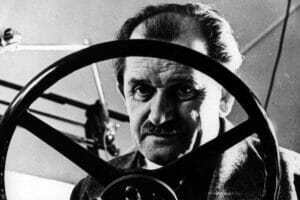
Among classic car enthusiasts it is relatively common to hear that the Renault 4CV was a Ferdinand Porsche design. For some reason this claim has become widespread, but it is – more than probably – of questionable veracity. As discussed in the excellent book “FASA RENAULT Y LOS RENAULT TODO ATRÁS FABRICADOS EN ESPAÑA” from author Gimeno Valledor, the Renault 4CV was a car designed in clandestinity during the German occupation in France, and under strict rules dictated by the German occupants that strictly prohibited the realization of any civilian vehicle design. Therefore, Ferdinand Porsche, born in Austria but with German nationality, could hardly participate in a design for the occupied country contraindicating the rules dictated by the authorities of his own country.
It is true that at the end of the war, Ferdinand Porsche was imprisoned in France, but by then the Renault 4CV was practically finished. And it seems that Ferdinand Porsche had some occasional contact with Renault’s managers, contact that took place due to political pressure towards Pierre Lefacheux (Renault’s manager at that time), and it seems that he was shown the design and/or prototype of Renault’s car. But his only contribution seems to have been some commentary – apparently positive – and not much more.
The Renault 4CV shares the idea of shapes with the VW Beetle -this one designed by Porsche-, as well as the concept of “engine and transmission behind”, but the Renault 4CV’s shapes are also reminiscent of the Morris Minor (U.K), the American Bantam, the 1940 Willys coupe, the 1950 Peugeot 203, and certainly many other cars of the time. Which is not surprising, since that was then the concept model at the time in terms of aerodynamic optimizations for body designers.
Renault 4CV in Spain
In Spain it was manufactured between 1951 and 1961 by FASA-Spain at the Valladolid plant, being popularly known as the “four-four” (cuatro-cuatro in Spanish), being the first car model in Spain to be mass-produced (even before the Seat 600). The Renault CV model is included in the list of the “Industrial Heritage of Spain”. The name 4-4 came from advertising in France, which featured 4 doors, 4 passengers, 4 fiscal horsepower (according to the French legislation of the time), and 440000 francs (from the old French francs before 1960).
In Spain it was manufactured between 1951 and 1961 by FASA-Spain at the Valladolid plant, being popularly known as the “four-four” (cuatro-cuatro in Spanish), being the first car model in Spain to be mass-produced (even before the Seat 600). The Renault CV model is included in the list of the “Industrial Heritage of Spain”. The name 4-4 came from advertising in France, which highlighted 4 doors, 4 passengers, 4 fiscal horsepower (according to the French legislation of the time), and 440000 francs. The history of the production of this model was actually born from the need that the political regime in Spain in those post-war years was interested in creating another brand of vehicles besides SEAT and Enasa, controlled by the INI (National Institute of Industry) of those years. Having tried Volkswagen in Germany and Morris in England, and having no success, Renault’s door was knocked on and Pierre Lefaucheux was positive about the proposal. The new Spanish company, owned by a group of banks and companies, was born under the name “Fabricación de Automóviles, S.A.”, and under the acronym of FASA España was settled in Valladolid for the production of the Renault 4CV in Spain. The factory was started up with an investment of 60 million pesetas at the time.approximately 160 million euros considering the CPI in terms of the country’s average income.with quite a lot of bureaucratic and administrative difficulties, it began to produce the first vehicles in August 1953. Some 26,000 units were manufactured at the FASA plant in Valladolid until the end of production in 1961.

